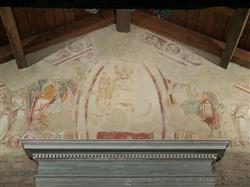|
Small Church of the Saints Filippo and Giacomo
|
|
|
Show an other treasure of art and history in Milan:
|
 Mostly represented styles: Gothic - Renaissance - Baroque Mostly represented styles: Gothic - Renaissance - Baroque
The Church of the Saints Filippo and Giacomo is located in Nosedo, currently a suburb of Milan, but originally a separate village, completely independent from Milan.
The place seems to have been inhabited since Roman times (first century AD), as evidenced by the oldest ceramics found under the church floor. According to it, the name Nosedo derives from the original Latin word "Nocetum".
The discovery of numerous Roman remains of a later period, including even a funerary inscription of the year 536, currently walled in the counterfacace, shows that the area was inhabited continuously over the following centuries.
The just quoted inscription shows also that already in Roman times on the site a Christian church was present, perhaps the building in the place of which the present church was later built.
The present church was built in the mid-thirteenth century, using partly the foundation of the church that it replaced.
As now it possessed a single straight room.
Starting from the fourteenth century it underwent several structural changes. In particular, a portico was added, which later, in the sixteenth century, was closed and united to the nave, after removing the thirteenth-century facade. In this way the church acquired the current rather elongated plan.
After a long period of neglect and decay, starting from 1985 the church enjoyed a number of restoration works (completed in 2015), thanks to which what was left has not gone lost forever.
The church has a very simple structure, being basically a simple rectangular building (to which at the bottom right corner a small sacristy was added) with a gabled roof. Externally there are no decorations present. The plaster on the rear wall has three "holes" to allow to appreciate the structure of the wall.
Above the rear facade there is a belfry.
Internally there are beautiful frescoes from the fourteenth century, in particular on the upper part of the rear wall, but also on other points of the upper parts of the walls. Above the altar it is possible to recognize a blessing Christ. To his right, to the left for the viewer, among other characters, an angel with an eagle's head, the symbolic representation of John the Evangelist.
Also the Baroque altar survived, to the left of which there is a white marble bas-relief depicting St. John.
A separate discussion deserve the graves that were discovered under the floor of the church during the restoration works. A window has been inserted in the floor in order to allow visitors to glimpse what lies beneath.
At least 76 people were buried in the church during a time span ranging from the Middle Ages to the sixteenth century.
The study of the remains, probably belonging to members of a medium-high social class for the presence of various jewelry and decorations, made it possible to collect data very useful to reconstruct the social and health situation of the people who lived in that area in the past centuries and their customs and way of living.
If you are interested in a guided tour of this monument send an email!
Categories: Churches / Religious buildings
Via S. Dionigi 77 - Nosedo, Milano (MI) |
Further pictures of the Small Church of the Saints Filippo and Giacomo in the section Photography |